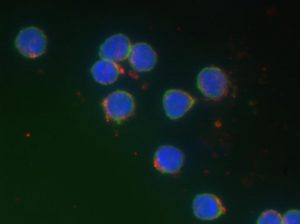Using Gold Nanoparticles for Vaccine Delivery
An international team of researchers has been able to demonstrate the impact of nanoparticles on human B lymphocytes, the immune cells responsible for antibody production. The results of their research, published in the journal ACS Nano, could lead to more effective vaccines and other therapeutics.

B lymphocytes (blue and green) and gold nanoparticles (red) measured with dark field hyperspectral imaging coupled with fluorescent detection. Credit: UNIGE.
Nanoparticles as Vaccine ‘Vehicles’
Because B lymphocytes are responsible for the production of antibodies, they are often targets for vaccine development. However, vaccines must reach B lymphocytes within the body quickly, or risk being destroyed. This is where nanoparticles come in – they can potentially harbor the vaccines.
“Nanoparticles can form a protective vehicle for vaccines – or other drugs – to specifically deliver them where they can be most effective, while sparing other cells,” said Dr. Carole Bourquin, a professor at the University of Geneva (UNIGE) and co-author of the study, in a press release. “This targeting also allows the use of a lower dose of immunostimulant while maintaining an effective immune response. It increases its efficacy while reducing side-effects, provided that the nanoparticles are harmless to all immune cells.”
Turning to Gold as a Solution
Because gold is well-tolerated by the body and malleable, it is an ideal candidate for nanomedicine and targeting tumors. For example, gold nanoparticles can deliver drugs to a specific location within a cell, or release heat in response to light exposure to destroy cancer cells.
To test these particles’ safety and formulation, the researchers created gold spheres with and without a polymer coating, as well as gold rods. They then exposed B lymphocytes to the particles to examine the immune response, by following the activation markers expressed on the B cells’ surface.
In the end, the immune response differed according to the shape and presence of the polymer coating. The gold nanorods inhibited the immune response instead of activating it, while the gold spheres with polymer coatings were stable and did not impair B lymphocyte function.
Looking Ahead with Gold
The gold nanoparticles that were developed by the researchers may be able to make it possible to deliver drugs directly to B lymphocytes. This can reduce the necessary dosage and side effects for patients. In addition, the study demonstrated for the first time a method for assessing the safety of nanoparticles on B lymphocytes.
Do you work in this line of research? Kerafast offers a variety of related lab-made reagents, including nanoparticles and tools for immunology study. You might be interested in:
- Functionalized Gold Nanoparticles from Portland State University
- CH12F3 B Lymphocyte Cell Lines from Michigan State University
- GlowDot Protein-Based Fluorescent Nanoparticles from University of Connecticut
- Human Chemokines from Medical College of Wisconsin


